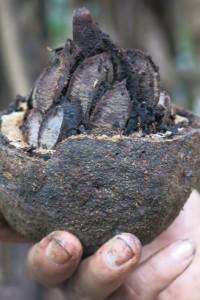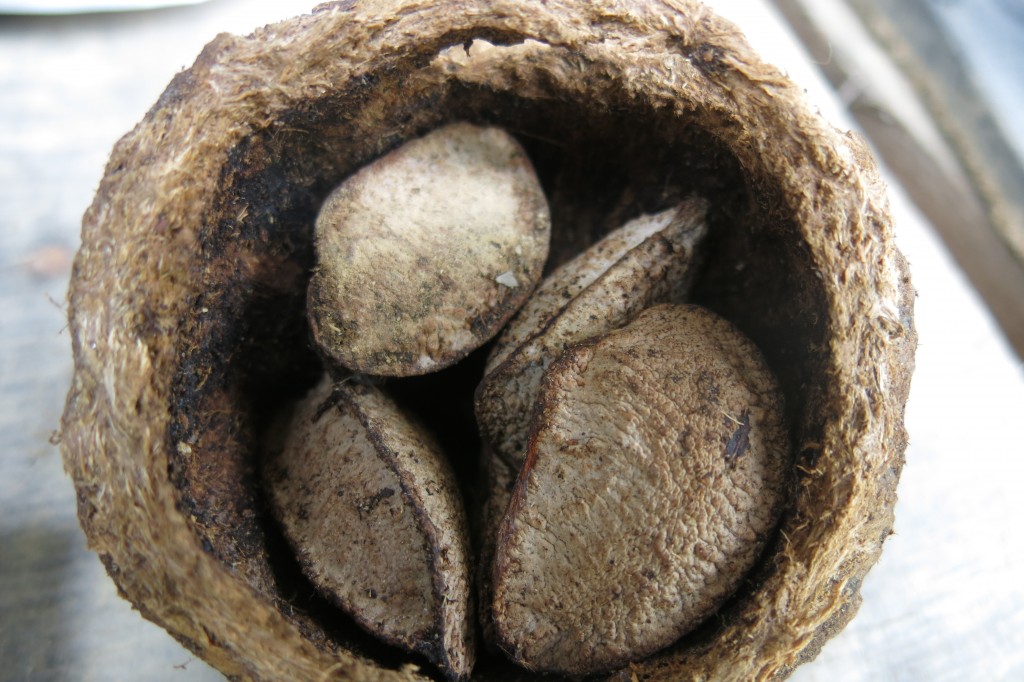I was in the Amazon rainforest of Peru to see how Brazil nuts make the long journey from forest to nut mix. I wasn’t expecting a gourmet treat, but they tend to show up in unexpected places.
Harvesting Brazil nuts is hard manual work, in remote areas, deep in the jungle. Harvesters spend long weeks in the forest gathering the cannonball-like fruit from the forest floor, shelling them on site and then hauling them in heavy loads miles through the forest. The harvest is intimately tied to the fate of the forest – the entire world harvest of these nuts is derived from centuries-old trees growing wild; there is virtually no plantation production. Simply put: no forests, no Brazil nuts. And conversely, the thousands of tons of Brazil nuts from the Amazonian regions of Bolivia, Peru and Brazil help make conserving these forests worthwhile for the many rural families that earn money from the annual harvest or zafra.

Shiwi, a thriving Peruvian company with a range of Brazil-nut based products, from granolas to lip-balm, was founded by Sofia Rubio, a biologist turned entrepreneur. Rubio had invited me for a visit to understand the road to market for Brazil nuts, or castaña, as they´re known locally, as part of a pilot ecotourism venture. Right now, she´s taken a break from showing us her Brazil-nut concession in the Tambopata Reserve of Peru, to lay out a bounty of native fruits on a rough wooden table in a clearing in the forest. There’s cupuaçu, a fruit that ought to conquer the world: a deep cocoa brown husk enclosing a sweet and tart, pear-and-piña-colada flavored pulp wrapped around chestnut-sized seeds. There’s a bowl of deep purple palm fruits (sinami) whose hard, seemingly unremarkable rind releases a frothy chocolatey nutty drink when beaten in warm water, and more laid out in a rustic tasting menu – sapote, aguaje, cocona… Every trip to the Amazon, or to an Amazon market, seems to yield something new.
But the highlight has to be Shiwi’s Brazil nut oil – cold-pressed, extra virgin, light and clear with a bit of a nutty finish. On this occasion used not just for salads, but for dipping lightly salted breadfruit seeds and earthy peach palm fruits ( in Peru). The Brazil nut oil reflects Shiwi’s approach to entrepreneurial conservation: a highly refined, value-added product, with roots deep in the forest and the people who for generations have worked it and conserved it. By creating excellent products derived from the nuts, Rubio and her company are helping to tell the story of the Brazil nuts’ forest ecology and economy, and trying to close the loop, with greater benefits flowing back from consumers to the Amazon.
 Brazil nut . Photo by Jacob Olander. Brazil nut . Photo by Jacob Olander. |
It’s striking, in this case as in so many others, how invisible the origins of commonplace products can be – and how fascinating they are when you dig a bit deeper. And how empowering the story of those origins can be when connections can be made between consumers, businesses, forests and communities. The story of Brazil buts, Shiwi and Rubio are described eloquently in this recent piece by Barbara Fraser on Mongabay, which we reproduce in full here, with thanks to the author and much appreciation for the hard work of Rhett Butler and Mongabay in telling so many conservation stories, so well.
Make sure you also check out Candela, a Peruvian fair trade organization that’s also been working with Brazil nut collectors, exporting globally and working to make connections to bring value back to local communities and the rainforest.
Jacob Olander, Canopy Bridge



That sounds lovely Kate! I remember carolers coming to our house when I was little (on the east coast U.S.), but I honestly have not seen that out here on the west coast. Definitely something I miss!